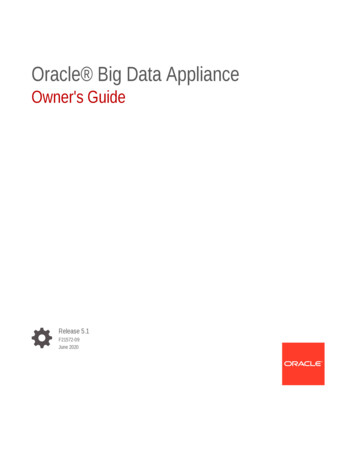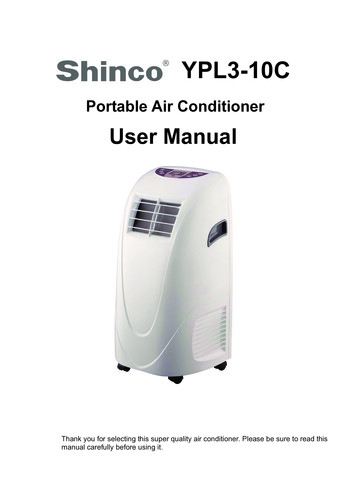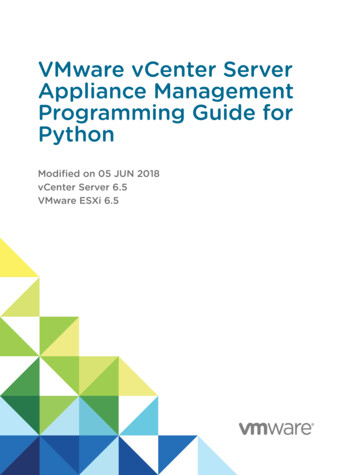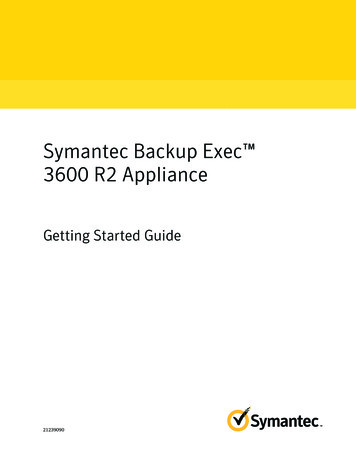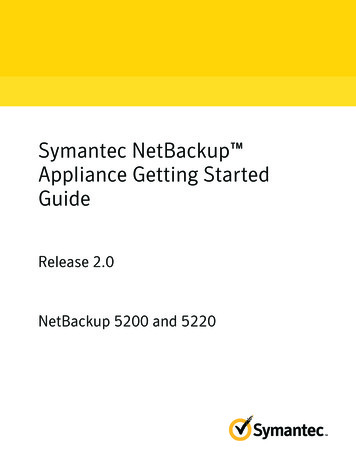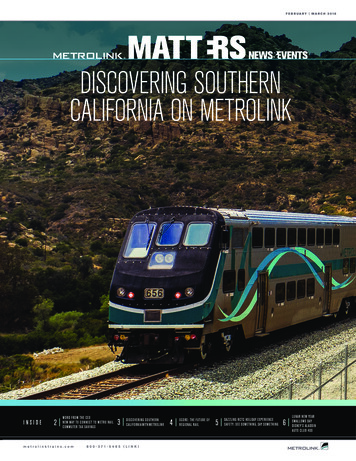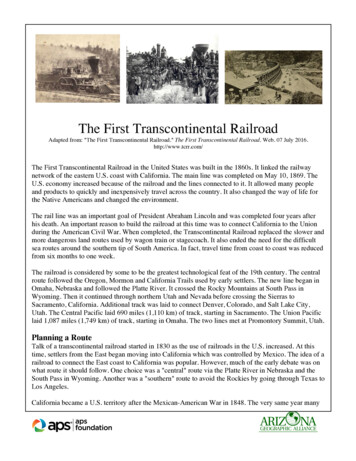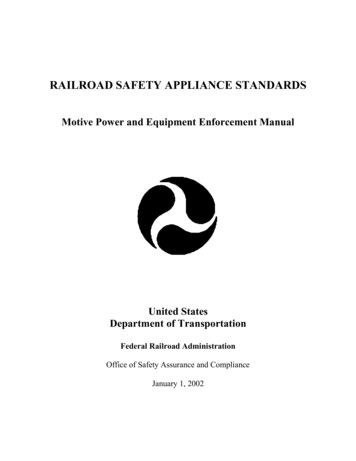
Transcription
RAILROAD SAFETY APPLIANCE STANDARDSMotive Power and Equipment Enforcement ManualUnited StatesDepartment of TransportationFederal Railroad AdministrationOffice of Safety Assurance and ComplianceJanuary 1, 2002
TABLE OF CONTENTSApplication of Regulation and Inspection GuidanceApplication of Regulation and Inspection Guidance . List of Illustrated Plates .Introduction . .Railroad Safety Appliance Standards Inspection Procedure . .Waivers .Authority and Basis for Regulation and Inspection Definitions or Clarifications .iii11-0111-0211-0611-0711-08PART 231 -- RAILROAD SAFETY APPLIANCE 231.5§231.6§231.7§231.8Applicability and penalties .Box and other house cars built or placed in service before October 1, 1966 Hopper cars and high-side gondolas with fixed ends Drop-end high-side gondola cars .Fixed-end low-side gondola and low-side hopper cars Drop-end low-side gondola cars Flat cars .Tank cars with side platforms Tank cars without side sills and tank cars with short side sills andend platforms .§231.9 Tank cars without end sills §231.10 Caboose cars with platforms §231.11 Caboose cars without platforms .§231.12 Passenger-train cars with wide vestibules .§231.13 Passenger-train cars with open-end platforms .§231.14 Passenger-train cars without end platforms .§231.15 Steam locomotives used in road service .§231.16 Steam locomotives used in switching service .§231.17 Specifications common to all steam locomotives §231.18 Cars of special construction .§231.19 Definition of "Right" and "Left." .§231.20 Variation in size permitted .§231.21 Tank cars without underframes §231.22 Operation of track motor cars .§231.23 Unidirectional passenger-train cars adaptable to van-type semi-trailer use §231.24 Box and other house cars with roofs, 16 feet 10 inches or more abovetop of rail . .§231.25 Track motorcars (self-propelled 4-wheel cars which can be removedfrom the rails by men) . 8511-8711-8711-9211-9611-9911-101
§231.26 Pushcars .§231.27 Box and other house cars without roof hatches or placed in service afterOctober 1, 1966 §231.28 Box and other house cars with roof hatches built or placed in serviceafter October 1, 1966 §231.29 Road locomotives with corner stairways .§231.30 Locomotives used in switching service §231.31 XXX .§238.229 Safety Appliances §238.429 Safety Appliances as Applied to Tier 2 Equipment Safety Appliance Defect Code and Penalty Schedule Safety Appliance Technical Bulletins . 1-13211-13649 CFRTransportationSubtitle B - [Other Regulations Relating To Transportation (Continued)]CHAPTER IIFEDERAL RAILROAD ADMINISTRATION, DEPARTMENT OF TRANSPORTATIONLink to an amendment published at 66 FR 4192, Jan. 17, 2001.This amendment was delayed until May 31, 2001, at 66 FR 9906, Feb. 12, 2001.Authority; 49 U.S.C. 20102-03, 20131, 20301-03, 21301-2, 21034:49 CFR 1.49(c),(m).Source; 33 FR 19663, Dec. 25, 1968, unless otherwise noted.Note: Where rivets or bolts are required in this part 231 a two-piece steel rivet maybe usedconsisting of:(a) A solid shank of one-half (1/2) inch minimum diameter steel or material of equal or greaterstrength having cold forged head on one end, a shank length for material thickness fastened,locking grooves, breakneck groove and pull grooves (all annular grooves) on the opposite end.(b) A collar of similar material, which is cold, swaged into the locking grooves, for the oppositeend of item (a) after the pull groove section has been removed.Note: Former TB MP&E-98-14 The Railroad Safety Appliance Standards, 49 CFR §231,requires that Railroad Safety Appliances and their brackets be secured by ½ inch bolts with nutsoutside (when possible) and riveted over, or with not less than ½ inch rivets. There must be adeformation of the threads of the fastener from becoming insecure. This can be accomplished byone of the following methods; rivet the fastener, chisel to a 1 inch depth at the threaded portionof the bolt nearest the fastener or apply weld to the threads. Additional approved securementmethods are; 1 and 2 piece rivets, bolts, huck bolts, and unilock and disc lock fasteners whenproperly applied.
iList of Illustrative Locomotive PlatesPlate “A”Locomotive Switching Step Arrangement .11-118Plate “B”Switching Step inside relief for clearance for Six Wheel Truck. 11-119Plate “S-1” Steam Locomotives used in Switching Service 11-78Plate “S-2” Tenders of Steam Locomotives used in Switching Service .11-79Plate “S-3” Steam Locomotives used in Road Service 11-74Plate “S-4” Tenders of Steam Locomotives used in Road Service .11-73Plate “S-5” Tenders of Vanderbilt Type .11-82List of Illustrative Car PlatesPlate “A”Efficient Hand Brake Arrangement with Ratchet Wheel and Pawl. 11-21Plate “B”Application to Outside Endsill Cars . 11-22Plate “C”Box and Other House Cars .11-180Plate “D”Box and Other House Cars (with platform end sills) .11-181Plate “E”Hopper Cars and High-Side Gondolas With Fixed Ends(Cars with sides more than 36” above floor) .11-182Plate “F”Hopper Cars and High-Side Gondolas With Fixed Ends (Carswith sides more than 36” above floor with Platform End Sills) 11-183Plate “G”Drop-End High-Side Gondola Cars (Cars with sides morethan 36” above floor) 11-184Plate “H”Drop-End High-Side Gondola Cars (Cars with Sides morethan 36” above floor with Platform End Sills) . 11-185Plate “I”Fixed-End Low-Side Gondola and Low-Side Hopper Cars(Cars with Sides 36” or less above floor) . 11-186Plate “J”Fixed-End Low-Side Gondola and Low-Side Hopper Cars(Cars with Sides 36” or less above floor with Platform End Sills) . 11-187Plate “K”Drop-End Low-Side Gondola Cars (Cars with Sides 36”or less above floor) . 11-188Plate “L”Drop-End Low-Side Gondola (Cars with Sides 36” orless above floor with Platform End Sills) . 11-189Plate “M”Flat Cars (Cars with sides 12” or less above floor maybeequipped same as Flat Cars) . 11-190Plate “N”Tank-Cars With Side-Platforms . 11-191Plate “O”Tank Cars Without Side-Sills and Tank Cars With ShortSide-Sills and End-Platforms . 11-192Plate “P”Tank Cars Without End-Sills . 11-193Plate “Q”Caboose Cars With Platforms . 11-194Plate “R”Caboose Cars Without Platforms . 11-195Plate “S”Tank Cars Without Underframes . 11-196Plate “T”Box and Other House Cars With Roofs 16 feet 10 inches ormore above Top of Rail 11-197Plate “U”Box and Other House Cars Without Roof Hatches . 11-198(Does not include cars with roofs 16 feet 10 inches or moreabove top of rail) . 11-199Plate “V”Box and Other House Cars With Roof Hatches . 11-191ii
Chapter 11Railroad Safety Appliance StandardsIntroductionThe purpose of this chapter is to promote safety in every area of railroad operations related toRailroad Safety Appliance Standards and reduce railroad-related accidents and incidents, i.e.handholds, sill steps, grates, walkways, railings, ladders, handbrakes, uncoupling levers, etc.This chapter prescribes the manner in which Federal and State railroad inspectors shall engage ininvestigation design monitoring, location, sacrament and inspection of Railroad Safety ApplianceStandards to assure railroad compliance with rules, regulations, orders, and standards issued bythe Federal Railroad Administration (FRA). It is an instrument of program management issuedsolely for the guidance of FRA and State personnel.It neither creates nor abridges any private right or obligation. The guidance provided by thischapter might be revoked or modified without prior notice by memorandum.11-01
Federal Railroad AdministrationRailroad Safety Appliance Standards Inspection Procedure49 CFR Part §231RAILROAD SAFETY APPLIANCE STANDARDS(Sections 231.0 - 231.30; 238.329 and 238.429)The minimum requirements for Railroad Safety Appliance Standards are prescribed in 49CFR §231; as of October 05. 1966This part describes minimum requirements for railroad standards rules and practices. Eachrailroad may prescribe additional and/or more stringent requirements in its mechanicalmaintenance, inspection standards, operating rules, and other special instructions. This Part alsorequires a railroad to take certain measures to ensure Railroad Safety Appliance Standardscompliance when engaged in movement, inspection and testing of rolling stock.On the following pages Motive Power & Equipment (MP&E) personnel will find the regulationand any related information needed to perform Railroad Safety Appliance Standards inspections.The actual regulation will be stated first, following application and guidance that is prepared bythe MP&E staff of the Office of Safety Assurance and Compliance. Following the listed Code ofFederal Regulations (CFR) part, starting on page 11-13 and each page thereafter, an applicationand guidance can be followed that will assist the MP&E inspector to conduct an effectiveRailroad Safety Appliance Standards inspection. Notes will also be included that denotedeviations and/or technical bulletins and/or existing fleet modifications.Description of FRA’s Sample Car Inspection process is provided in section 3-6 of this manual.Reporting codes MP&E inspectors are to use for inspection are defined in the Penalty Scheduleof 49 CFR §231, page 11-135.Reports of safety appliance standards are made on the Motive Power and Equipment InspectionReport, F6180.29 and 29.A.MP&E inspector(s) should incorporate railroad safety appliance standards inspections into theirroutine inspection activities.Before conducting any Railroad Safety Appliance Standards inspection, it will be necessary forthe MP&E inspector to familiarize him or herself with the regulation. Also, MP&E inspector(s)will need knowledge of any permissible alternative methods providing the required compliance.Before entering a particular location for inspection purposes, railroads are responsible forproducing any waivers of the CFR, which have been duly granted. If a waiver document is notreadily produced, corrective action should be pursued. See Waivers pg. 11-06 of this part.11-02
Motive Power and Equipment Enforcement ManualIt is the railroad’s obligation to adhere to, and comply with all safety appliance standards. TheMP&E inspector’s responsibility is to monitor if compliance has been met. If not, the MP&Einspector must take corrective action with the operating railroad to comply with currentregulations.The Railroad Safety Appliance Standards contained herein were verified complete when thismanual was compiled and is inclusive of all applicable Technical Bulletins (TB’s) up to January1, 2002. It is the MP&E inspector’s responsibility to update this information whenever changesin the regulation and/or FRA’s policy are made.MP&E inspector(s) engaged in Railroad Safety Appliance Standards investigation activitiesshould refer to this chapter as often as necessary to obtain a clear understanding of their roles inthe implementation of 49 CFR §231 Railroad Safety Appliance Standards. If in doubt as to themeaning of any paragraph in the chapter, an MP&E inspector must promptly apply to his/ herSupervisor for an explanation.This manual gives an interpretation of each section for MP&E application and guidance, but isnot to be construed as a modification, alteration, or revision of the public standards or law.This manual will serve as the guideline for effective MP&E inspection and compliance activitiesrelated to CFR 49 §231 Railroad Safety Appliance Standards. In conjunction with this manualan MP&E Inspector must utilize basic knowledge and language related to the railroad industryand exercise good judgement as it applies to inspection, safety and compliance with 49 CFR§231 for the railroad industry in its entirety.MP&E inspector(s) must familiarize themselves with, and be able to identify the common typesof rail cars and their unique characteristics prior to performing inspections. MP&E inspector(s)should learn the types of cars to be inspected as a result of the many complexities of differentcars of special construction.Prior to performing inspections of 49 CFR §231 for compliance, requirements should include ajob briefing review. At that time, the MP&E inspector should proceed with appropriate cautionwhen entering live or unsecured tracks i.e. insure that blue signal protection is in place, ifneeded.There are very specific Railroad Safety Appliance Standards that apply to each type of rail car.All rail cars that are considered to be in revenue service unless on a shop track and repairs arebeing made to railroad safety appliance arrangements in which case, all repairs must becomplete. At times, a carrier inspector may shop a car, and defects will be identified by the useof a Bad Order Tag with the appropriate information regarding the known defect and action to betaken.11-03
Federal Railroad AdministrationRailroad Safety Appliance Standards for compliance must be met prior to car or train movement.After a mechanical inspection of the train has been performed, any Railroad Safety ApplianceStandard that is non-compliant with 49 CFR §231 can be subject to violation of this part.MP&E inspector(s) should be governed by leniency and/or strictness when conductinginvestigations with regards to: history of compliance, commodities transported, train location,mechanical forces, and/or duty of the Carrier to make a proper repair for compliance. Theexisting conditions, which warrant removal of a rail car from service, vary greatly. Conditionsare broad in regard to examination of Railroad Safety Appliance Standards, and can appear lessthan definitive. In such cases, this manual and direction of the Regional Supervisor, and/or theHeadquarters MP&E Staff Director, should guide the MP&E inspectors’ discretion, if necessary.49 CFR §231 contains specific detailed dimensions, specifications and guide for each type railcar. Submission for new car designs will be received on a regular basis some are classified as“ Cars of Special Construction”, and are generally non-compliant with some Part of the RailroadSafety Appliances Standards in their design. These cars are then required to comply with theRailroad Safety Appliance Standards for the car type that it most closely resembles. Wheninspecting cars of special construction and relief of compliance is requested by the carrier, it maybe necessary to contact the cars’ manufacturer for proof of relief by specific mention of a letterfrom the Office of Safety Assurance and Compliance. This letter must indicate that waiver ofrelief was provided or no exceptions were taken to the specific deviation of the Railroad SafetyAppliance Standard.Note: Former TB MP&E-98-36- There have been recent exceptions taken by FRA’s MP&Einspector’s with minimal deviations from the measurements specified in the Railroad SafetyAppliance Standards on cars that have been in service with these conditions for a long period oftime without any known incident or casualty. Although these civil penalty citations are validfrom a technical and legal point of view, from a common sense point of view the cars haveoperated safely for years, so these minimal deviations did not reduce safety.MP&E inspector(s) tend to view railroad safety appliance standards as requiring the issuance ofcivil penalty citations if strict adherence to each number, dimension, location, and manner ofapplication not maintained. The railroad operating environment has drastically changed: in somuch as, crews are smaller, flat switching is rare and the number of run-through trains is muchgreater, all decreasing the use of Railroad Safety Appliances.Most of the Railroad Safety Appliance Standards were developed nearly 100 years ago and carswere mostly of standard design. Today most cars are “ Cars of Special Construction “, (see 49CFR §231.18). The Railroad Safety Appliance Standards for such cars must be determined fromthe “nearest approximate type” of an identified standard car.11-04
Motive Power & Equipment Enforcement ManualThe Railroad Safety Appliance Standards cannot be applied to these cars without exercisinggood judgment. MP&E inspector(s) must exercise this judgment, not just take exceptions forminimal deviations. An exception should be taken when the condition of the Railroad SafetyAppliance materially reduces safety. Exactly, what materially reduces safety is not always clear,it is a judgment call often dependant on the unique set of conditions covering the operations atthat time. Guidance for Railroad Safety Appliance Standards are as follows: don’t take exceptionto non-complying design feature of a type of car that has a long and continuous, safe servicehistory. When a Railroad Safety Appliance moves easily to the touch (not secure), exceptionshould be taken. If a significant force greater, which would be encountered in normal use oroperation of the Railroad Safety Appliance, is required, exceptions should generally not be taken.The enforcement of the Railroad Safety Appliance Standards needs to be determined byexercising good judgement, so that scarce FRA railroad resources are not consumed pursuingminor infractions that do not materially reduce safety.11-05
Federal Railroad AdministrationWAVIERSWhen rolling stock is not in compliance as identified in the drawing plates in this chapter, awaiver request must be submitted to the FRA to grant revenue use of the equipment. Manypossibilities may be used to determine if rolling stock will be allowed to continue in revenueservice with a non-compliant condition. FRA potentially may use enforcement measures to gaincompliance through regulatory measures or FRA may require the car owner or carrier to complyas determined by the FRA Safety Board through the “Request for Waiver” process. Specialcircumstances are required to apply for a wavier. Some examples are to “meet the needs ofindustry or customer use” and “new cars of special construction” that have no regulatoryguidance as outlined in part §231”. Each non-conforming safety appliance on a car that has beengranted a waiver will have certain outlined requirements stipulated by the FRA Safety Board.Waivers may be permanent as a result of a known long duration of a non-compliant conditionwith no potential of ever compliant or a waiver may be granted within specified time constraints(usually five (5) years). The Car Owner or Carrier must seek the application for continuation of awaiver before expiration of a specified time waiver for continued use of the rolling stock. Forspecified time waiver cases that are close to expiration, continuation of the waiver will bereviewed for previous stipulations that were outlined for granting the original waiver and, toensure, all those requirements were met. The Car Owner or Carrier must provide circumstancesthat may or may not have changed, and rational for continued use to the FRA Safety Boardbefore granting or denial a continuation of a new waiver.MP&E inspector(s) should look at the date(s) and condition(s) met when performing aninspection to determine if the Car Owner or Carrier meets the requirements for the granting thewaiver. The requirements must be met before the car can be used in revenue service. In the eventa waiver was not in conformity as outlined in the granting of the waiver, the MP&E inspectorshould take exception to all or any parts that were not met. MP&E inspector(s) should takespecific notes, photographs and compile any related information of the non-compliant safetyappliance or deviation and forward all the information to their Regional Supervisor orHeadquarters MP&E Staff Director. In some cases, deviations on drawing plates on safetyappliance arrangements that are considered out of the plate drawing or non-compliant with minoror minimal infractions are to be considered safe for use. If in doubt, the MP&E inspector shouldnotify his/her Regional Supervisor or Headquarters MP&E Staff Director. The MP&EHeadquarters Staff Director will determine if the infraction was noted and not taken exception onthe sample car inspection and if request for waiver should be sought, if not in already in place.MP&E inspector(s) should be cautious in their approach and guidance for any waiver, and attimes, should be coordinated with their Regional Supervisor or MP&E Headquarters StaffDirector.11-06
Motive Power & Equipment Enforcement ManualAuthority and Basis for Regulation and InspectionThe authority to establish Railroad Safety Appliance Standards are contained in the Code ofFederal Regulations 49 CFR §231, were first established under Public Law 89-670.Public Law 89-670, approved October 1966 (49 U.S.C. 1651-9), established the United StatesDepartment of Transportation. Pursuant to that law, certain functions, powers, and duties of theInterstate Commerce Commission were transferred to and vested in the Secretary ofTransportation, including the following laws relating generally to safety appliances andequipment on railroad engines and cars, and protection of employees and travelers:(A) The Act of March 2, 1893, as amended, (27 Stat. 531; 45 U.S.C. 1 et seq.).(B) The Act of March 2, 1903, as amended, (32 Stat. 943; 45 U.S.C. 8 et seq.).(C) The Act of April 14, 1910, as amended, (35 Stat. 298; 45 U.S.C. 11 et seq.).(D) The Act of July 5, 1994, as amended, (108 Stat. 864, Public Law 103-272, Chapter203, Sec. 20301, Safety Appliances.Public Law 89-670 (49 U.S.C. 1655 (f) (3) (a) ) further provided that the Federal RailroadAdministrator shall carry out the functions powers, and duties of the Secretary pertaining torailroad safety as set forth in the statues transferred to the Secretary.Also included in this publication are Part §231, Railroad Safety Appliance Standards, and Part§232, Railroad Power Brakes and Drawbars.These Parts are codified under title 49 of the Code of Federal Regulations.Plates A through V are provided to show safety appliance arrangements. For specific details seeappropriate text. The U.S. Safety Appliance Standards are administered by the Federal RailroadAdministration, U.S. Department of Transportation, Washington, DC 20590.Submission for sample Car inspection and/ or foe new car or series of cars are regularlyrequested and typically do not meet some of the requirements of 49 CFR 231. In those instances,cars are considered Cars of Special Construction (re) 49 CFR 231.18, and may remain in service.11-07
Federal Railroad AdministrationDefinitions or Clarifications(Definitions or Clarification: as used in this Part- Definitions described in this manual aregeneralized; however, each definition, herein is specific to all Parts when applied.)Adjustable Handhold Ladder Tread – Handhold Ladder Tread will be ¾- inch in diameter.The length may be adjusted as needed by application of a ¼ inch roll pin intodesired hole. The remaining portion is to be cut off, leaving a smooth surface. Ifany deficiency is found concerning this safety appliance, such as substitution ofroll pin, improper securement, etc. it should be reported to the RegionalSupervisor or Headquarters MP&E Staff Director with all pertinent information,including photographs.Aluminum Alloy Handholds – Handholds that have a circular cross-section, 13/16-inchdiameter when constructed of 6061-T6 exceeds the current FRA requirements.Bottom of Caboose cars with platforms – means the “bottom of side-sill or sheathing overside-sill.”Brake Shaft – Arrangements should have a square fit at its upper end to secure the handbrakewheel and be securely fastened with bolts or rivets. The lower end of brake shaftshould be secured with a trunnion extending through brake shaft step and securedwith a cotter or ring. The brake shaft drum will be the prescribed diameter. A keyshould secure the brake ratchet wheel or square fit and has the required number ofteeth. There will be a rigid metal connection between the brake pawl andbrakeshaft with the pivot pawl secured by a bolt or rivet. The brake wheel will beheld in position on the brakeshaft by a nut on a threaded extended end, secured bya nut riveted over or by the use of a lock nut or cotter and will be arranged with asquare fit for brake shaft taper as required.Brake Step - Will be of required clear depth, running parallel to the car.Brake Wheel – Must be constructed of malleable iron, wrought iron or steel and located where itcan be safely operated while car is in motion.Clearance - Two inches is required in all directions or 360 degrees around the handhold orladderClear Depth - A vertical space, the width of, and above, the sill step material or strap, and thevertical space shall be clear and unobstructed for 8 inches with minimumclearance of 2 inches.11-08
Motive Power & Equipment Enforcement ManualCorner of car - (Bottom of caboose cars with platforms) is used to mean the "line at inner edgeof platform formed by the intersection of the side and end of car."End Ladder Clearance - Except for buffer block, brake shaft, brake wheel, brake step, runningboard or uncoupling lever should extend within 12” of the end of the car. No partof the car above the end sills should be within 30” from the side of the car.FRA Approved Fasteners - Where rivets or bolts are required in this part §231 a two-piece steelrivet maybe used consisting of:(a) A solid shank of one-half (1/2) inch minimum diameter steel or material ofequal or greater strength having cold forged head on one end, a shank length formaterial thickness fastened, locking grooves, breakneck groove and pull grooves(all annular grooves) on the opposite end.(b) A collar of similar material, which is cold, swaged into the locking grooves,for the opposite end of item (a) after the pull groove section has been removed.Note: Former TB MP&E-98-14 The Railroad Safety Appliance Standards, 49 CFR §231,requires that Railroad Safety Appliances and their brackets be secured by ½ inchbolts with nuts outside (when possible) and riveted over, or with not less than ½inch rivets. There must be a deformation of the threads of the fastener frombecoming insecure. This can be accomplished by one of the following methods;rivet the fastener, chisel to a 1-inch depth at the threaded portion of the boltnearest the fastener or apply weld to the threads. Additional approved securementmethods are: 1 and 2 piece rivets, bolts, huck bolts, and unilock and disc-lockfasteners when properly applied.Hand Brake – The Hand Brake shall operate in harmony with the power brake installed on thecar. Each such handbrake shall provide the same degree of safety as the designshown on plate A. The minimum-braking ratio of 11% at the brake shoes with aspecific force output at the handbrake (equivalent to 125 pounds on the rim of thewheel). The handbrake force must act on one-half of the axles including the “B”end truck as outlined by AAR.Handholds/Grab Irons – Must have proper diameter and are secure with FRA approvedfasteners in the required manner. There must be a minimum clear useable lengthwith proper clearance.11-09
Federal Railroad AdministrationHandhold Securely Fastened – Means free from danger or risk of loss; free from fear or doubt;and not likely to give way. All safety appliances, supports and brackets must bemechanically fastened to car structure other than a tank car tank supports andbrackets only. Safety appliances and their brackets be secured by ½ inch boltswith nuts outside (when possible) and riveted over, or with not less than ½ inchrivets.There must be a deformation of threads to prevent fastener from becominginsecure.This can be accomplished by riveting the fastener, check the threaded portion ofthe bolt nearest the fastener with a chisel to inch depth at the two locations orapplying weld to the threaded portion of the threads. Additional approvedfasteners are one and two piece rivets, bolts, Huck bolts, and Unilock and Disclock fasteners when properly applied. See FRA approved fasteners.Horizontal End Handholds – The prescribed distance above centerline and one near each endof rail car, and securely fastened with nuts and bolts and riveted over.Ladders – Will be minimum clear length of tread, proper placement on side and end of car. Topladders must be located the required space from the roofs at eaves. When rail carconstruction prohibits required application of tread location of the first tread,requirements will be applied to the second tread from the side of the ladder. Thelocation should be measured from the inside edge of the ladder stile. Foot guardsor upward projections are required on metal ladders. At no time should any partof a rail car above end sills or fixtures exceed required placement. The Radialdoor and its application to auto rack cars have the following FRA requirementsdue to variations of misalignment of 5 to 13 inches that have been adapted:Standard Level Cars- Relationship of Sill Step to Side LadderAll Cars- 2- 3/16 inch maximumLow Level Cars:Built 1978 & prior- 5 inch maximumBuilt after 1978- 4 inch max
Railroad Safety Appliance Standards Introduction The purpose of this chapter is to promote safety in every area of railroad operations related to Railroad Safety Appliance Standards and reduce railroad-related accidents and incidents, i.e. handholds, sill steps, grates, walkways, railings, ladders, handbrakes, uncoupling levers, etc.

